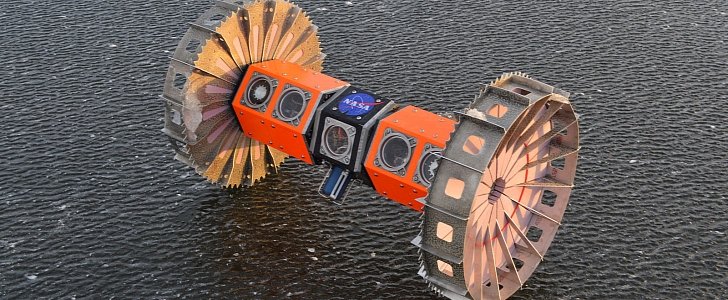The Universe is so vast that it’s only a matter of time before we find aliens, be it tiny little ones shaped like microbes and with no trace of awareness whatsoever. The only question that remains is where will we find them?
After spending decades scanning the solar system for the best place to look, humans have come up with several possibilities. One of them is beneath the frozen surface of whatever liquid happens to freeze over on other planets.
But how does one look under the ice, millions of miles away and possibly 6 to 12 miles thick (10 to 19 km)?
One solution could be the Buoyant Rover for Under-Ice Exploration rover, or BRUIE, currently under development at the NASA Jet Propulsion Laboratory. The robot is designed specifically to look for stuff under icy waters of alien worlds.
And it will do so in a very unlikely fashion: driving through the liquid, inverted, on the wrong side of the ice.
Presently, NASA has deployed BRUIE in Antarctica, where it will be tested while tethered to the surface. Engineers will work to see how its instruments, including two live, high-definition cameras, work.
BRUIE is just beginning to take shape, and the agency is a long way from a robot capable of doing its thing elsewhere, untethered, but people are working on it.
"The ice shells covering these distant oceans serve as a window into the oceans below, and the chemistry of the ice could help feed life within those oceans,” said in a statement Kevin Hand, JPL lead scientist on the project.
“Here on Earth, the ice covering our polar oceans serves a similar role, and our team is particularly interested in what is happening where the water meets the ice."
For now, NASA does not say where it plans to send the robot and when; there is also the question of how to get the machine under miles of ice, but once these things are sorted out, we’ll likely get one of the best exploration tools ever made.
But how does one look under the ice, millions of miles away and possibly 6 to 12 miles thick (10 to 19 km)?
One solution could be the Buoyant Rover for Under-Ice Exploration rover, or BRUIE, currently under development at the NASA Jet Propulsion Laboratory. The robot is designed specifically to look for stuff under icy waters of alien worlds.
And it will do so in a very unlikely fashion: driving through the liquid, inverted, on the wrong side of the ice.
Presently, NASA has deployed BRUIE in Antarctica, where it will be tested while tethered to the surface. Engineers will work to see how its instruments, including two live, high-definition cameras, work.
BRUIE is just beginning to take shape, and the agency is a long way from a robot capable of doing its thing elsewhere, untethered, but people are working on it.
"The ice shells covering these distant oceans serve as a window into the oceans below, and the chemistry of the ice could help feed life within those oceans,” said in a statement Kevin Hand, JPL lead scientist on the project.
“Here on Earth, the ice covering our polar oceans serves a similar role, and our team is particularly interested in what is happening where the water meets the ice."
For now, NASA does not say where it plans to send the robot and when; there is also the question of how to get the machine under miles of ice, but once these things are sorted out, we’ll likely get one of the best exploration tools ever made.



